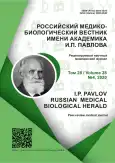Смертность от всех причин у пациентов с инфарктом миокарда с подъемом сегмента st в зависимости от типа реперфузионной терапии (данные рязанской области, 2018-2020 гг.)
- Авторы: Паршикова Е.Н.1, Филиппов Е.В.2
-
Учреждения:
- ГБУЗ МО Люберецкая областная больница
- ФГБОУ ВО Рязанский государственный медицинский университет им. акад. И.П. Павлова Минздрава России
- Выпуск: Том 28, № 4 (2020)
- Страницы: 479-487
- Раздел: Оригинальные исследования
- Статья получена: 28.10.2020
- Статья одобрена: 12.11.2020
- Статья опубликована: 15.12.2020
- URL: https://journals.eco-vector.com/pavlovj/article/view/48650
- DOI: https://doi.org/10.23888/PAVLOVJ2020284479-487
- ID: 48650
Цитировать
Аннотация
Цель. Оценить летальность и смертность от всех причин у пациентов, перенесших инфаркт миокарда с подъемом сегмента ST (ИМпST) в зависимости от типа реперфузионной терапии.
Материал и методы. Из 1456 пациентов, госпитализированных с острым коронарным синдромом с подъемом сегмента ST, для анализа случайным образом было отобрано 848 случаев. Сбор информации о конечной точке (смерть от любых причин) продолжался в течение 18 месяцев. Настоящие данные получены на момент 01.10.2020, медиана наблюдения составила 20,8 [17,4;23,6] месяцев.
Результаты. В группе пациентов, не получивших реперфузионную терапию, 18-месячная летальность была самой высокой (42,3%). При этом, показатели летальности за 30 дней в группе тромболитической терапии (ТЛТ) и группе без реперфузии значимо не различались (20,3% vs 26,2%, р>0,05). Госпитальная, 30-дневная и 12-месячная, 18-месячная летальность от всех причин в группе чрескожного коронарного вмешательства (ЧКВ) составила соответственно 8,4, 10,6, 16,6 и 18,3% и была значимо ниже по сравнению с группой пациентов, не получивших реперфузию (19,5, 26,2, 36,2 и 42,3% соответственно, р<0,05). Наиболее значимые различия в частоте конечной точки были зарегистрированы при достижении 18-месячного рубежа: в группе лиц без реперфузии летальность составила 42,3%, что выше (р<0,05) по сравнению с данным показателем в группе ТЛТ (27,1%), ЧКВ (18,3%) и ТЛТ+ЧКВ (13,1%).
Заключение. За 18 месяцев наблюдения наиболее низкая летальность от всех причин наблюдалась в группе фармакоинвазивного подхода и первичного ЧКВ, наиболее высокая – в группе пациентов, не получивших реперфузионную терапию.
Полный текст
Об авторах
Елена Николаевна Паршикова
ГБУЗ МО Люберецкая областная больница
Email: philpoiuy@yandex.ru
ORCID iD: 0000-0003-0349-3456
SPIN-код: 2809-2781
зав. приемным покоем
Россия, Люберцы, Московская областьЕвгений Владимирович Филиппов
ФГБОУ ВО Рязанский государственный медицинский университет им. акад. И.П. Павлова Минздрава России
Автор, ответственный за переписку.
Email: dr.philippov@gmail.com
ORCID iD: 0000-0002-7688-7176
SPIN-код: 2809-2781
ResearcherId: O-1490-2016
д.м.н., доцент, зав. кафедрой поликлинической терапии и профилактической медицины
Россия, РязаньСписок литературы
- Alkhalil M., Choudhury R.P. Reperfusion Treatment in Late Presentation Acute Myocardial Infarction: Timing Is Not Everything // Circulation: Cardiovascular Interventions. 2018. Vol. 11, №9. Р. e007287. doi: 10.1161/CIRCINTERVENTIONS. 118.007287
- Эрлих А.Д. Шестимесячные исходы у пациентов с острым коронарным синдромом, включённых в российский регистр РЕКОРД-3 // Российский кардиологический журнал. 2017. Т. 22, №11. С. 8-14. doi: 10.15829/1560-4071-2017-11-8-14
- Марцевич С.Ю., Семенова Ю.В., Кутишенко Н.П., и др. Регистр острого коронарного синдрома ЛИС-3: что изменилось за прошедшие годы в «портрете» больного и ближайших исходах заболевания в сравнении с регистром ЛИС-1 // Рациональная Фармакотерапия в Кардиологии. 2017. Т. 13, №1. С. 63-68. doi: 10.20996/1819-6446-2017-13-1-63-68
- Кутишенко Н.П., Калайджян Е.П., Сичинава Д.П., и др. Амбулаторный регистр больных, перенесших острый инфаркт миокарда (ПРОФИЛЬ-ИМ): данные о догоспитальной терапии в сравнении с регистром ЛИС-3 // Рациональная Фармакотерапия в Кардиологии 2018. Т. 14, №1. С. 88-93. doi: 10.20996/1819-6446-2018-14-1-88-93
- Эрлих А.Д. 12-месячные исходы у пациентов с острым коронарным синдромом, включённых в российский Регистр «РЕКОРД-3» // Российский кардиологический журнал. 2018. №3. С. 23-30. doi: 10.15829/1560-4071-2018-3-23-30
- Российский статистический ежегодник 2019. М.; 2019. Доступно по ссылке: https://rosstat. gov.ru/storage/mediabank/Ejegodnik_2019.pdf. Ссылка активна на 27 октября 2020.
- Sanchis-Gomar F., Perez-Quilis C., Leischik R., et al. Epidemiology of coronary heart disease and acute coronary syndrome // Annals of Translational Medicine. 2016. Vol. 4, №13. P. 256. doi:10.21037/ atm.2016.06.33
- Biery D.W., Berman A.N., Singh A., et al. Association of Smoking Cessation and Survival Among Young Adults with Myocardial Infarction in the Partners YOUNG-MI Registry // JAMA Network Open. 2020. Vol. 3, №7. P. e209649. doi: 10.1001/jamanetworkopen.2020.9649
- Fazel R., Joseph T.I., Sankardas M.A., et al. Comparison of Reperfusion Strategies for ST-Segment-Elevation Myocardial Infarction: A Multivariate Network Meta-analysis // Journal of the American Heart Association. 2020. Vol. 9, 312. P. e015186. doi: 10.1161/JAHA.119.015186
- Ibanez B., James S., Agewall S., et al. 2017 ESC Guidelines for the management of acute myocardial infarction in patients presenting with ST-segment elevation: The Task Force for the management of acute myocardial infarction in patients presenting with ST-segment elevation of the European Society of Cardiology (ESC) // European Heart Journal. 2018. Vol. 39, №2. P. 119-177. doi: 10.1093/eurheartj/ehx393
- Распоряжение Правительства Рязанской области от 27 июня 2019 №301-р «Об утверждении региональной программы Рязанской области «Борьба с сердечно-сосудистыми заболеваниями». Доступно по: http://docs.cntd.ru/document/553385694. Ссылка активна на 27 октября 2020.
- Peiyuan H., Jingang Y., Haiyan X., et al. The Comparison of the Outcomes between Primary PCI, Fibrinolysis, and No Reperfusion in Patients ≥ 75 Years Old with ST-Segment Elevation Myocardial Infarction: Results from the Chinese Acute Myocardial Infarction (CAMI) Registry // PLoS One. 2016. Vol. 11, №11. P. e0165672. doi:10.1371/ journal.pone.0165672
- Limwattananon C., Jaratpatthararoj J., Thungthong J., et al. Access to reperfusion therapy and mortality outcomes in patients with ST-segment elevation myocardial infarction under universal health coverage in Thailand // BMC Cardiovascular Disorders. 2020. Vol. 20. doi: 10.1186/s12872-020-01379-3
- Ложкина Н.Г., Хасанова М.Х., Стафеева Е.А., и др. Прогнозирование отдаленных исходов острого инфаркта миокарда со стойким подъемом сегмента ST на ЭКГ в реальной клинической практике // Современные проблемы науки и образования. 2018. №6. Доступно по: http://science-education.ru/ru/article/view?id=28172. Ссылка активна на 27 октября 2020.
Дополнительные файлы













